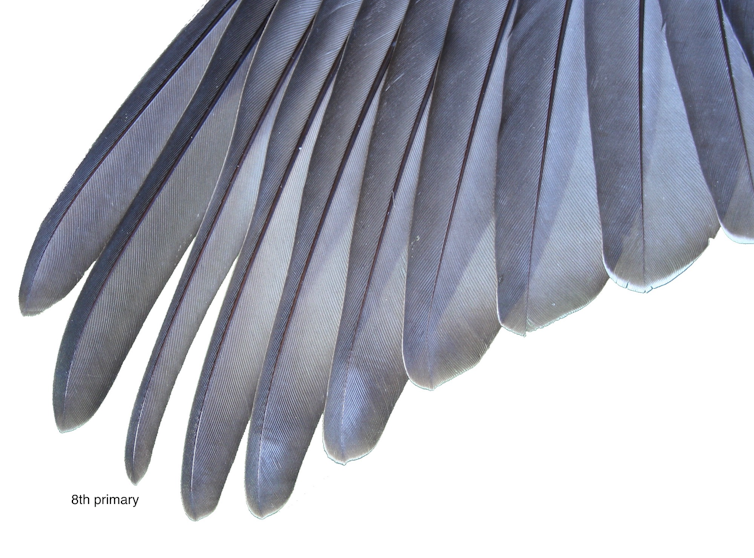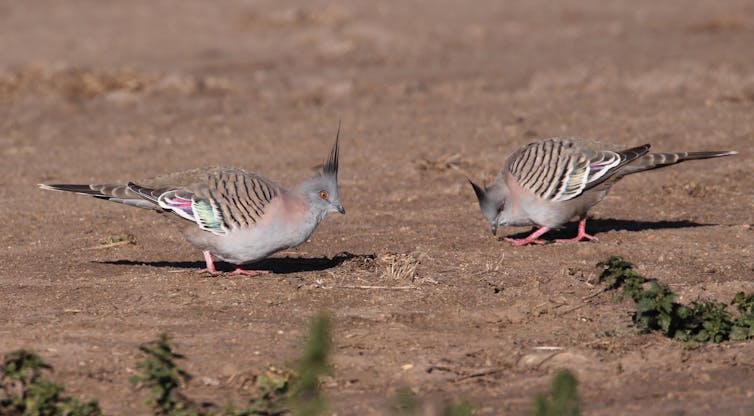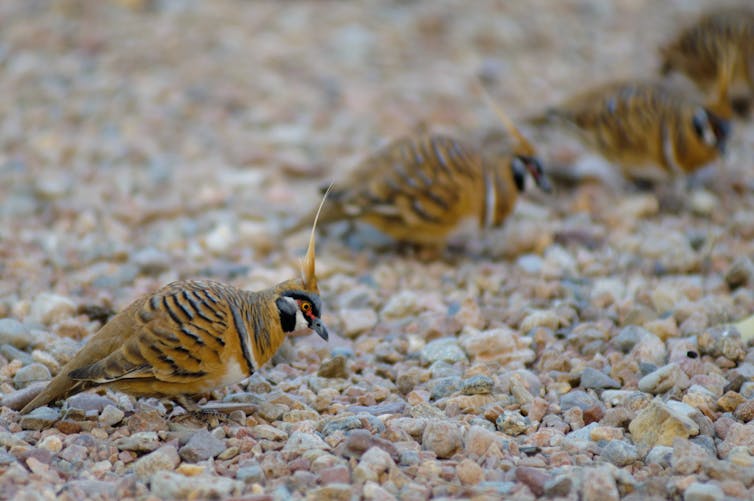Those noisy crested pigeons use their unique feathers to sound an alarm
- Written by Trevor Murray, Postdoctoral Scientist, Australian National University
Crested pigeons are a common sight in many Australian backyards, and are noted for the rapid trilling sound they make when they take flight.
In our research, published today in Current Biology, we show that these sounds are produced by feathers in the wings that have evolved to communicate about danger.
These sounds were long suspected of being produced by the wings, so we used high-speed video and acoustic recording to investigate this.
Read more: Citizen scientists count nearly 2 million birds and reveal a possible kookaburra decline
The key finding is that a pair of unusual primary flight feathers, half the width of the others, produce a high-pitched sound as the wing pushes down through the air. This sound is a critical part of the alarm signal that warns the flock.
 The wing of a crested pigeon showing the thinner 8th primary feather.
Trevor Murray, Robert Magrath and Jochen Zeil, Author provided
The wing of a crested pigeon showing the thinner 8th primary feather.
Trevor Murray, Robert Magrath and Jochen Zeil, Author provided
No other related pigeon species has these unusually narrow wing feathers. The narrowness of these feathers, known as the the 8th primary feathers, suggests that they have evolved to produce this high-pitched sound.
Feathers to the test
We discovered that the 8th primary feathers produce the high-pitched sound, by trimming pairs of feathers and recording the sounds of pigeons fleeing. But we were also interested in how trimming the 8th primary feathers would affect the response of other crested pigeons that heard these modified fleeing sounds.
We developed a speaker set up that let us broadcast the recorded fleeing sounds of birds from the side of a vehicle. We would then drive next to pigeons foraging in parks and on nature strips around Canberra, and broadcast one of the recordings at random.
When we played recordings of crested pigeons with both the 8th primary feathers removed, the birds looked up, but almost never flew off.
Our suspicions were correct - this unusual pair of 8th primary feathers and their high-pitched sound were necessary for warning other pigeons to flee.
So what about the neighbouring 9th primary feathers? We discovered that these produce a low-pitched sound during take-off.
When we played recordings of crested pigeons with both the 9th primary feathers removed, the birds flew off just as often as if they’d heard an alarm. These feathers were not necessary for warning flock mates.
All in a flap
Signals evolve when the creature producing the signal and the one responding to it both benefit.
Crested pigeons that see predators can benefit by inciting the rest of the flock to flee with them, much like redshanks and Belding’s ground squirrels, whose coordinated fleeing confuses predators.
 A pair of crested pigeons on the ground.
Geoffrey Dabb, Author provided
A pair of crested pigeons on the ground.
Geoffrey Dabb, Author provided
The benefit from communication to every individual could explain why the 8th primary is so unique - it has evolved to exaggerate the sounds of fleeing to trigger a coordinated response.
While these pigeons always produce some sound when they take off, the sounds produced when fleeing danger are distinct. They are louder and have a higher tempo.
A crested pigeon takes flight in slow motion.Footage from high-speed video cameras showed that fleeing pigeons flap faster when trying to escape a threat. Flapping faster speeds up their escape and it also increases the tempo of the sound, thus transforming the take-off sound into an alarm.
While these differences in the sound can be quite subtle to the human ear, crested pigeons are able to respond to them in about a third of a second. (Can you tell the difference between these two sounds?)
All animals produce some sound as they move, and these sounds are intrinsically informative. They tell the listener where the individual is and how it is moving. This is in stark contrast to the sounds produced by our voices, which are not the result of specific actions.
The same is true for animals: vocal calls are notoriously unreliable, even being used deceptively to steal food. Africa’s fork-tailed drogos, for example, often use their own, and even other species, vocal alarms to scare competitors away and steal their food.
Non-vocal sounds, by comparison, are unable to be faked. If a crested pigeon flees it cannot help but warn its flock mates, just as it cannot warn its flock mates without fleeing.
This means that these non-vocal alarms are a very reliable indicator of danger – and, more broadly, that non-vocal sounds produced by movement are intrinsically informative and so are likely to evolve for communication.
Other feathered messages
Crested pigeons aren’t the only birds that use their feathers to communicate. We know of several other pigeon species that produce conspicuous sounds with their wings that are just waiting to be investigated, such as the Spinifex pigeon.
 Spinifex pigeon in the Northern Territory.
Flickr/Kristian Golding, CC BY-NC-ND
Spinifex pigeon in the Northern Territory.
Flickr/Kristian Golding, CC BY-NC-ND
Mourning doves and zenaida doves from the Americas also make sounds, that appear to be produced by their wings, that warn their flock mates of danger.
Read more: New research reveals the origin of Australia’s extinct flightless giants, the mihirung birds
Non-vocal acoustic signals are used in many other groups to maintain territories and attract mates – manakins and hummingbirds being the most widespread examples.
It appears that non-vocal acoustic communication is much more common than most people thought, and so we hope a new generation of curious people are inspired to listen closely to the animals around them and discover even more of these unusual signals.
Authors: Trevor Murray, Postdoctoral Scientist, Australian National University



